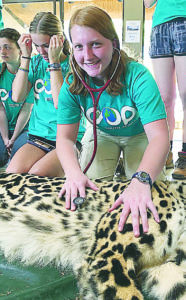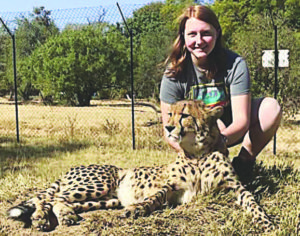A 2018 Oxford High School graduate spent some time in Africa this summer working with and learning about a big cat that many experts claim is dangerously close to extinction in the wild.
For two weeks, Jordyn Hughes, 18, volunteered at Feracare Wildlife Centre, a reserve located in Bela-Bela, a town in South Africa’s Limpopo Province.
There, she worked with and cared for cheetahs. She fed them. She weighed and measured them. She administered vaccinations and watched medical procedures performed by veterinarians. She even got to listen to a cheetah’s heartbeat with a stethoscope.

“It was pretty hands-on,” said Hughes, a sophomore at Michigan State University.
Hughes is majoring in animal science with a pre-vet concentration. Right now, her goal is to become a small animal veterinarian.
“I absolutely love animals,” she said.
Hughes has wanted to be a veterinarian for as long as she can remember.
“For Halloween, I didn’t dress up as a doctor or a nurse. I dressed up as a vet,” she said. “Everybody said, ‘Oh look, you’re a doctor.’ I said, ‘No, I’m a vet.’”
Hughes traveled to South Africa as part of Loop Abroad, a study-abroad organization that offers animal science and veterinary programs for students and young adults age 14 to 30. Programs range in length from two weeks during the summer to a full-semester abroad. Financial aid, assistance with fund-raising and college credit are all available.
The Feracare Wildlife Centre, where Hughes worked, is a fairly new organization. Founded in October 2015, the place is designed to be a safe haven for “all animals.” The property contains impala, kudu, blue wildebeest, zebra, giraffe, sable, antelope, ostrich, hartebeest, various smaller animals and of course, cheetahs.
Although it houses many different creatures, Feracare’s primary mission is “to ensure the long-term survival of the cheetah species through maintaining a strong genetic pool with the aim to release them into protected areas if and when they become available.”
Hughes was astounded by how well-behaved and well-trained some of the cheetahs were, particularly the ones that are classified as “ambassadors” and used for breeding.
At feeding time, she would go inside some of the fenced-in areas with bowls of minced meat, tell the cheetahs to sit and look away, and they would obey.
“You’re able to put the bowl down right in front of them,” Hughes said.
Hughes always felt “pretty comfortable” around the cheetahs thanks to Feracare’s staff, which never required her to do anything that made her feel uncomfortable.
“They were always by our side and they would show us exactly what to do before we did it,” she said. “It was pretty safe.”
Overall, she found the cheetahs she encountered to be “really sweet” and “lovable.”
Contrary to what people may think, Hughes said cheetahs are not “strong,” independent animals that can “take care of themselves” when it comes to facing enemies and threats. She said when confronted in the wild, “they don’t want to fight.”
“They would rather run,” Hughes said. “They’re kind of just big scaredy-cats.”

According to the Feracare website, cheetahs can go from zero to 100 kilometers (or 62 miles) per hour in 3 seconds. They are the world’s fastest land animal.
Hughes got to witness that lightning speed as Feracare has cheetah runs that allow visitors to watch these big cats in action as they chase lures meant to simulate prey in the wild.
“It was kind of insane,” she said. “They just zoom around this entire field and they’re back in like a couple seconds . . . It was great to see the cheetahs stretch their legs . . . It was amazing to see how wide they open up (in terms of their stride) to (make) just one leap.”
Hughes will never forget what it was like to touch a cheetah.
“They’re a lot rougher than I thought. Their fur is kind of rough. I thought it would be nice and soft,” she said.
The fur on their back, along their spine, is soft, but the rest is “a little bit coarse,” Hughes noted.
On the educational side, Hughes learned a lot at Feracare that will help her as she pursues a career in veterinary medicine, including how to examine fecal matter and calculate drug dosage based on an animal’s weight. Her favorite part was learning and practicing suturing techniques.
“They catered to our learning,” she said. “They wanted to teach us everything that they could in the two weeks. They had lectures every day and questions were always welcome.”
In addition to working with the animals at Feracare, Hughes helped make improvements to the reserve. She enjoyed putting up thatching along the fences to provide shade for the cheetahs.
Hughes is also proud that she was part of a group of about 30 people that worked together over a two-day period to create a firebreak to protect the sanctuary.
A firebreak is an area of cleared or plowed land that’s designed to act as a barrier to slow or stop the progress of a wildfire.
While in South Africa, Hughes visited Kruger National Park. It contains nearly 2 million hectares (or 4.9 million acres) of land and has a high density of wild animals, including lions, rhinos, elephants, leopards and buffalo.
“They have a lot of land to roam at the national park and they’re protected there,” Hughes said.
Hughes loved coming face-to-face with animals she had previously gotten to know through “National Geographic or in coloring books.”
“I’ve just never seen animals like that in real life. It was crazy to see them up close,” she said.
Hughes was amazed to find that impalas “are everywhere” in Africa.
“Impalas (there) are like deer are to us,” she said.
Her visit also made her fond of hyenas.
“No one really likes hyenas because of ‘The Lion King,’ but they’re actually kind of cool,” Hughes said.
Looking back, Hughes is extremely grateful to the Feracare staff for providing her with such a memorable and educational trip.
“They always made the day fun,” she said. “There was always something to do. They fed us well. It was just a really great environment to be in.”
“I honestly couldn’t have had a better experience. I really want to give them credit,” Hughes added.

Leave a Reply